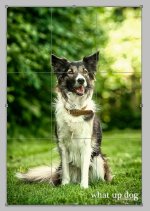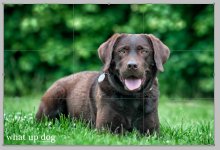I think ultimately your choice in terms of what you like or do not like in the image is up to you. It is all part of your own personal style, which is perfectly fine. There have been, however, during the course of the history of the photographic art, some ideas about aesthetics and what makes a photograph "work" or make it artistically better, much in the way that paintings have been viewed for centuries. The idea behind the bright area in the background is that it is a distraction to the eye, without us being conscious of it. It might provide a sense of depth or place and I can understand the need to have something more than a sterile green background. But portraiture has traditionally held the notion of making the subject the first thing that they eye should be drawn too. The eyes naturally go to the dogs eyes first, then down the chest to the legs and then to the tail. The white area pulls the eyes away from that natural progression. Imagine your eyes just wandering in an image. Where do they go? It is part of that journey that takes us through the image in terms of what interests us the most. If you wish your viewer to be interested in the white spot in the background then that is your artistic perogative, certainly. Compositionally however, there is the rule of thirds and placing the subject dead center in the photograph defeats that. That is why I placed the dog just slightly off center and having him look into the "dead" space rather than out of it. That creates balance. The eyes lead into the space, the tail leads out of the space. That give us a sense of where the dog might be looking toward or heading toward, as the case might be, rather than the dog statically remaining in that one place locked in position which in my view makes the image feel constrained and the dog itself constrained and confined, like a cage. He's in the open, so I would put him in the open and convey something of that, even with this relatively tight cropping, but including just a bit of place.
The same applies to portrait work. You don't see professional wedding photographers putting their subjects dead center all the time in an image. They are always off center and that makes it more interesting compositionally. The same holds true whether it is a dog or a bride and groom, or even a tree, or a cup.



